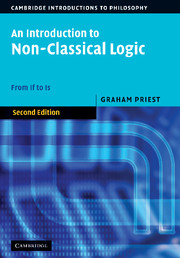Book contents
- Frontmatter
- Contents
- Preface to the First Edition
- Preface to the Second Edition
- Mathematical Prolegomenon
- Part I Propositional Logic
- Part II Quantification and Identity
- 12 Classical First-order Logic
- 13 Free Logics
- 14 Constant Domain Modal Logics
- 15 Variable Domain Modal Logics
- 16 Necessary Identity in Modal Logic
- 17 Contingent Identity in Modal Logic
- 18 Non-normal Modal Logics
- 19 Conditional Logics
- 20 Intuitionist Logic
- 21 Many-valued Logics
- 22 First Degree Entailment
- 23 Logics with Gaps, Gluts and Worlds
- 24 Relevant Logics
- 25 Fuzzy Logics
- Postscript: A Methodological Coda
- References
- Index of Names
- Index of Subjects
16 - Necessary Identity in Modal Logic
Published online by Cambridge University Press: 05 June 2012
- Frontmatter
- Contents
- Preface to the First Edition
- Preface to the Second Edition
- Mathematical Prolegomenon
- Part I Propositional Logic
- Part II Quantification and Identity
- 12 Classical First-order Logic
- 13 Free Logics
- 14 Constant Domain Modal Logics
- 15 Variable Domain Modal Logics
- 16 Necessary Identity in Modal Logic
- 17 Contingent Identity in Modal Logic
- 18 Non-normal Modal Logics
- 19 Conditional Logics
- 20 Intuitionist Logic
- 21 Many-valued Logics
- 22 First Degree Entailment
- 23 Logics with Gaps, Gluts and Worlds
- 24 Relevant Logics
- 25 Fuzzy Logics
- Postscript: A Methodological Coda
- References
- Index of Names
- Index of Subjects
Summary
Introduction
16.1.1 In this chapter we will start to look at the behaviour of identity in modal logic. (Henceforth, I use ‘modal logic’ to include tense logic.) There are, in fact, two kinds of semantics for identity in modal logic: necessary and contingent.
16.1.2 Where it is necessary to distinguish between the two notions of identity, I will use the following notation. If S is any system of logic without identity, S(NI) will denote the system augmented by necessary identity, and S(CI) will denote the system of logic augmented by contingent identity. In this chapter we will deal with necessary identity, which is simpler; in the next chapter, we will turn to contingent identity.
16.1.3 We will assume, first, that the Negativity Constraint is not in operation. We will then see how its addition affects matters.
16.1.4 Next, we will look at the distinction between rigid and non-rigid designators, and see how non-rigid designators can be added to the logic.
16.1.5 Finally, there is a short philosophical discussion of how this distinction applies to names and descriptions in a natural language such as English.
Necessary Identity
16.2.1 Assume that we are dealing with any quantified (constant or variable domain) normal modal logic (without the Negativity Constraint). As in the classical case (12.5.1), we now distinguish one of the binary predicates as the identity predicate.
16.2.2 The denotation of the identity predicate is the same in every world, w, of an interpretation: νw(=) = {〈d, d〉 : d ∈ D}.
- Type
- Chapter
- Information
- An Introduction to Non-Classical LogicFrom If to Is, pp. 349 - 366Publisher: Cambridge University PressPrint publication year: 2008



